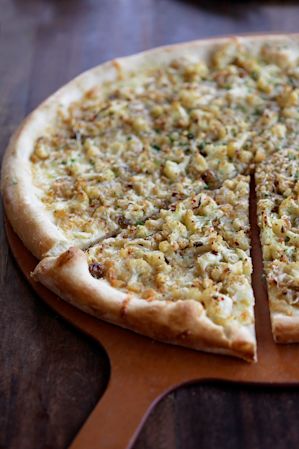The Archeology of Taste: New Seasonals

Our new seasonal pizzas offer glimpses into Italian history.
Food nourishes us, it thrills us, it brings us together. It’s part of our culture. It’s also a tangible historical document—one you can eat! Sicilian food, for geographical and political reasons, is a vibrant, complicated history of occupation. A millennium ago, Arabs inhabited Sicily for nearly 300 years, leaving an indelible mark. Then followed the Greeks, Romans, Normans, Spanish, French, and Italians. Just like it can be hard to isolate particular ingredients in a long-simmered sauce, it can be challenging to understand which culture the elements of a specific dish came from. But some are easier than others. Take couscous, a clear Arab influence, as is the addition of raisins to savory dishes. Our seasonal pizza, Sicilian Cauliflower, draws on this tradition. Riffing on a classic cauliflower preparation in Sicily, we brush our crust with olive oil and then top it with tender, spiced-up roasted cauliflower and an Arab-Sicilian influenced medley of raisins, parsley, mozzarella, parmesan and breadcrumbs. A taste will explain why this flavor combination has stood the test of time.

Our seasonal Amatriciana pizza takes its name and flavors from the pasta famous to Rome. Like many things with a long past, dig deep enough, and you find some historical controversy. Some Romans claim the recipe originated in Rome, even though it bears the name of Amatrice, the medieval Italian hill town in central Italy. In Amatrice, those are fighting words—the namesake pasta is their heritage and an indelible contribution to Italian cuisine. What everyone will agree on is that it’s a wonderful pasta—and that their version is the best. As much as we love the pasta, we think our Amatriciana pizza deserves a nod. It stars the rich salty-sweetness of pancetta, a bacon-like meat. We layer crisp pancetta over creamy fresh mozzarella and a crushed Italian tomato base seasoned with chili pepper flakes. After baking, we finish the pie with a sprinkle of fresh parsley.

For many people, it’s not a real dinner if there is no dessert. Since we’re on the subject of history, we should note that while the tradition of finishing a meal with a sweet has its origins in France, the Italians (like so many) fell in love with the idea. A popular Italian “dolce” is Baci di Dama (“lady’s kisses”). Especially around Valentine’s Day. The cookie is made of two almond hazelnut biscuits that sandwich a chocolate filling. The two halves vaguely resemble two lips pursed for a kiss. We like to think of them as two parts of a whole (“One's not half of two; two are halves of one.” E.E. Cummings). Gelatiamo makes an amazing melt-in-your-mouth version of Baci di Dama from a family recipe. Maybe even more amazing than their cookies is its transformation into gelato. Chunks of Baci di Dama cookies are mixed into a creamy almond and Italian hazelnut base and flecked with chocolate hazelnut ganache. Maria Coassin, the owner of Gelatiamo, says, “It is one of the most labor-intensive flavors we make, but it's absolutely divine.”

